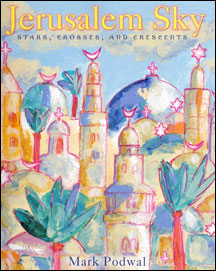![]()
Jerusalem Sky- Stars, Crosses, and Crescents
by Mark Podwal
Doubleday-Random House, 2005
Reviewed by Tessa Bielecki
Simple children’s books are sometimes deep inspiration for adults. This is true of Jerusalem Sky, written and illustrated by Dr. Mark Podwal.

The book begins, “With wonders and miracles, the sky over Jerusalem touches the world below. Legend says that the Jerusalem sky has a hole in it, made by a jewel that fell from God’s throne. Through this hole, hopes reach heaven.” If the world ever needed hopes to reach heaven from Jerusalem, it is now.
At first, Podwal’s publisher found his book “too Jewish, too inaccessible.” Doesn’t this convey the major problem with the ancient sacred city of Jerusalem? Whose is it anyway? The Jews’? The Christians’? The Muslims’?
After visiting Jerusalem in 2003, Podwal said that he finally understood the city’s common significance. This is clearly indicated in both his profound text and magnificent watercolors of “synagogue stars, church crosses, mosque moons.” The book’s subtitle, Stars, Crosses, and Crescents, sums up the centrality of this holy city for all three Abrahamic traditions, for all three “Peoples of the Book.”
“Jerusalem is so loved it has seventy names,” Podwal writes. “Though it is called City of Peace, no place has been fought over more. Seventeen times torn apart and rebuilt.” With searing wisdom and insight others would do well to emulate, he concludes: “Perhaps possessing Jerusalem is like trying to own the sky.”
I especially loved the descriptions of Jerusalem through its morning and midnight moods and throughout the four seasons of the year: “Every autumn gust tossing a leaf, every winter cloud storming overhead, every spring breeze rustling a treetop, every summer rainbow promising sunshine, is said to be born in the Jerusalem sky.”
This little volume is only twenty-eight pages long. With very few words and the vibrant colors of the Middle East – blue, orange, purple and gold – Podwal illustrates the importance of the holy city for Jews, Christians, and Muslims:
“Jewish sages tell how, night after night, a full moon shone while Solomon was king. Under his rule the Temple was built….enemies burned down the Temple,…By the stones that remain, Jews still pray.”*
“Christians tell of a wondrous star in the Jerusalem sky, which brightened the winter night, announcing the news of Jesus’ birth. And they tell how thirty-three years later, a spring afternoon’s daylight blackened into starless night when Jesus died on a small jagged hill, now crowned by a great church.”
“Muslims tell of the prophet Muhammad’s night journey in which midnight glowed like day when he rode through the sky on a flying horse, then reached heaven on a stairway of light. Where Muhammad rose to heaven now stands a mosque with sky blue stones and a dome of gold shining like a second sun.”
Podwal’s two-page drawing of this Dome of the Rock is the most striking in the book. It also conveys his remarkable openness, since the structure, built in the seventh century C.E. on the former Jewish Temple mount, is a source of tension for many other Jews.
Podwal is actually a dermatologist. When not drawing, he serves as a clinical associate professor at New York University School of Medicine. An accomplished artist, his work has appeared in the New York Times for over thirty years and is also represented in the Metropolitan Museum of Art, among others.
Jerusalem Sky was a two-year effort for Dr. Podwal and a soul-searching experience for him. “Sometimes I can spend a night finding the right word,” he confessed.
A unique project was sponsored by the Anti-Defamation League when the book was first published. Fourth and fifth graders from Jewish, Roman Catholic, and Muslim schools in Brooklyn were each given a copy of the book and asked to create their own artworks showing Jerusalem’s importance to all three of the world’s major monotheistic religions. As Marty Markowitz, president of the Brooklyn borough, read the book aloud to the children in a final ceremony, he donned in succession a yarmulke, a cleric’s collar (unfortunate, since this is a symbol of authority and not a symbol of prayer), and a Muslim prayer cap.
One young Jewish girl did a portrait of a golden-domed synagogue. Her explanation is a source of hope for all of us: “It reminded me of a dream I once had, where there was a door, and behind the door the whole world was at peace. I hope that everyone together can open that door some day.”
“Too many people have a one-dimensional view of Jerusalem,” said Dr. Podwal with tears in his eyes. These students “made it three-dimensional.”
*It is helpful to know that the remaining western wall is not from the original temple built by Solomon but the temple rebuilt by King Herod in 20 B.C.E.